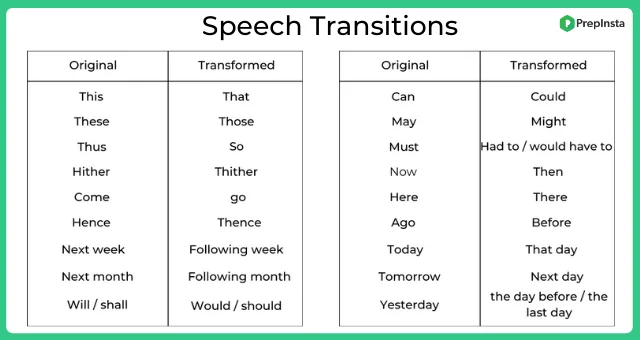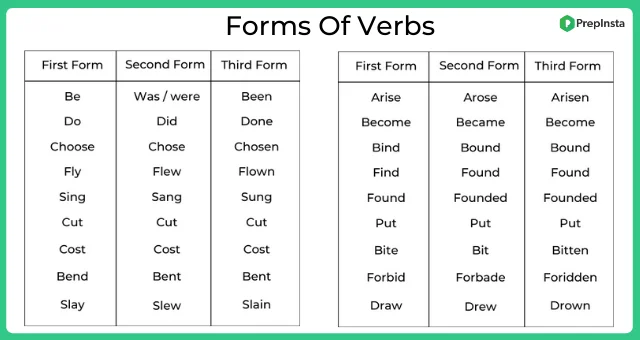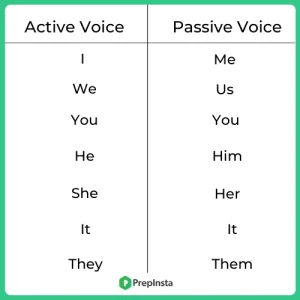Verbal Menu
- Basic Grammar
- Speech and Voices
- Tenses
- Articles
- Tenses and Articles
- Idioms and Phrases
- Subject Verb Agreement
- Prepositions and Conjunction
- Selecting Words
- Relative Pronoun
- Sentence Completion
- Sentence Ordering
- Contextual Vocabulary
- Jumbled Sentence
- Sentence Formation
- Error Identification
- Sentence Improvement and Construction
- Cloze Test
- Fill in the blanks
- Paragraph Ordering
- Para Jumbles
- Synonyms and Antonyms
- Synonyms
- Antonyms
- Reading Comprehension
- Get Off-campus Drive Updates
- Get Hiring Updates
- Contact US
PREPINSTA PRIME
Rules For Speech And Voices
Rules for Speech and Voices
Here we are provided with rules for speech and voices to solve the verbal questions quickly and it is provided with the important rules for the each and every topic to analyze the concept and tricks to solve the questions easily and accurately .
With the help of these rules we can understand the basic concept and detail of the verbal topics asked in the companies and helped in the placement for the better score and result

Speech
Speech is the expression of thoughts in spoken words. It is known as something which is spoken.
Here are some rules for Speech and Voices –
In general Language it is divided into two parts mainly:
- Direct Speech –
- Speech which is used to convey directly and exactly what is said.
- It is usually represented through inverted commas and quotes.
- Example – She said, “Go and close the door”.
- Indirect speech –
- It is used to convey what was said indirectly instead of a direct speech.
- Example – She told me to go and close the door.
Voice
In general English language, the transitive verb has two voices mainly Active voice and Passive voice.
- Active Voice –
- sentence has a subject that acts upon its verb.
- Example – She scolded him
- sentence has a subject that acts upon its verb.
- Passive Voice –
- a subject is a recipient of a verb’s action.
- Example – He was scolded by her.
- a subject is a recipient of a verb’s action.
This was the brief idea of how Speech and Voice works but let’s get towards the detailed Rules for Speech and Voices on this page below. Keep Reading.
Rules For Speech - Direct & Indirect Speech

Rule 1 – Converting Direct to Indirect – Reporting Verb
- When a reporting verb in the direct speech sentence is in past tense, then while converting it to indirect speech, all present tense transforms to past tense.
- For Example:
Direct: He said ” I am playing guitar”
Indirect: He said (+ that) he was playing guitar.
- For Example:
Exceptions:
- While translating to indirect speech, the tense remain the same if the direct sentence talks about any universal fact.
- For Example:
Direct: She said, “We cannot live without food”.
Indirect: She said that we cannot live without food.
- For Example:
- When a reporting verb in the direct speech sentence is in present tense or future tense, then while converting it to indirect speech, the tense doesn’t change to past.
- For Example:
Direct: He says/will say, “I will come tomorrow”
Indirect: He says/will say He will come tomorrow.
- For Example:
Rule 2 – Converting Direct to Indirect – Present to Past
- Simple Present Changes to Simple Past
- For Example:
Direct: My mother said “I am in the market”
Indirect: My mother said that she was in the market.
- For Example:
- Present Perfect Changes to Past Perfect.
- For example:
Direct: “I have been dancing all day” she said.
Indirect: She told me she had been dancing all day.
- For example:
- Present Continuous Changes to Past Continuous
- For Example:
Direct: “I am cleaning the house“, she said.
Indirect: She said that she was cleaning the house.
- For Example:
- Present Perfect Changes to Past Perfect
- For Example:
Direct: He said, “His team has won the match”
Indirect: He said that his team had won the match.
- For Example:
Rule 3 – Converting Direct to Indirect – Past and Future Tense
- Simple Past Changes to Past Perfect
- For Example:
Direct: Mary said “I went to the market”
Indirect: Mary said that she had gone to the market.
- For Example:
- Past Continuous Changes to Past Perfect Continuous
- For Example:
Direct: Karan told, “He was playing guitar”.
Indirect: Karan told he had been playing guitar.
- For Example:
- Future Changes to Present Conditional
- For Example:
Direct: She said, “I will play piano tomorrow at the auditorium”
Indirect: She said that she would play piano the next day at the auditorium.
- For Example:
- Future Continuous Changes to Conditional Continuous
- For Example:
Direct: She said,”I’ll be leaving the office next week”
Indirect: She said that she would be leaving the office the following week.
- For Example:
Rule 4 – Converting Direct to Indirect – Interrogative Sentences
- If a sentence begins with (what, where, when) as an interrogative sentence, then we do not use any conjunction (that).
- For Example:
Direct: “Where do you work?” asked the neighbor
Indirect: The neighbor asked where I worked.
- For Example:
- If a direct speech sentence begins with an auxiliary verb/helping verb, it takes the form of if / whether in the indirect clause.
- For Example:
Direct: She said, ” Were you there at the party yesterday?”
Indirect: She asked if I was there at the party the last day.
- For Example:
- Reporting verbs in direct speech change to asked, enquired, demanded in indirect speech.
- For Example:
Direct: She said to me,”Where are you going?”
Indirect: She asked m where was I going.Direct: She said, “Give me my watch back.”
Indirect: She demanded to give her watch back.
- For Example:
Rule 5 – Converting Direct to Indirect – Modal Transformation
In the process of translating direct to indirect speech, the modals change too:
- Can changes to could
- May changes to might
- Must changes to had to /would have to
Examples:
- Example 1:
- Direct: He said, “He can sing”
- Indirect: He said that he could sing
- Example 2:
- Direct: She said,” I may go to school tomorrow”
- Indirect: She said that she might go to school the next day.
- Example 3:
- Direct: Mary said, “I must attend the workshop”
- Indirect: Mary said that she had to attend the workshop.
However the modals that do not change their forms are – Could, Would, Should, Might, Ought to
- Example 1:
- Direct: She said,” I ought to complete the task by dusk”
- Indirect: She said that she ought to complete the task by dusk.
- Example 2:
- Direct: Alex said,”I would not be able to pick her up from school”
- Indirect: Alex said that he would not be able to pick her up from school.
Rule 6 – Converting Direct to Indirect – Pronoun
First Person – I, Me, Myself, Mine, Our, Ours, We, Ourselves
Second Person – You, Your, Yourself, Yours.
Third Person – She, Her, Hers, Herself, He, Him, His, Himself, They, Them, Themselves, Their, Theirs,
- First person changes as per the subject:
- For Example:
Direct: He said,”I am a coach in karate.”
Indirect: He said that he was a coach in karate.
- For Example:
- The second person changes as per the object of reporting speech.
- For Example:
Direct:She says to them, “You have completed your task.”
Indirect: She tells them that they had completed their task.
- For Example:
- The third person remains unchanged.
- For Example:
Direct: She says, “He sings well.”
Indirect: She says that he sings well.
- For Example:
Rule 7 – Converting Direct to Indirect – Request, Command, Wish, Exclamation
For Example:
- Direct: She said to her ‘Please fill this form’.
Indirect: She requested her to fill the form. - Direct: Mary said to Alex,”Bring me the keys.”
Indirect: Mary said Alex to bring her the keys.
- In Exclamatory sentences we remove the interjections (alas, oh, hurrah, bravo……) and change the sentence to assertive.
For Example:
- Direct: She said, “Alas! He is no more”
Indirect: She exclaimed sadly that he was no more. - Direct: They said,” Hurrah! We Won”
Indirect: They exclaimed excitedly that they won.
Rule 8 – Converting Direct to Indirect – Change in Time
- In direct speech words that objectify nearness will translate to distance verbs in indirect speech.
- Now becomes then
- Here becomes there
- Ago becomes before
- Thus becomes so
- Today becomes that day
- Tomorrow becomes the next day
- This becomes that
- Yesterday becomes the day before / the last day
- These become those
- Hither becomes thither
- Come becomes go
- Hence becomes thence
- Next week or month becomes following week/month
For Example:
- Direct: He said,”I went to the market yesterday”
Indirect: He said that he had gone to the market the last day. - Direct: She said” I kept the keys here“
Indirect: She said that she had kept the keys there.
- Direct: He said,”I went to the market yesterday”
Rules of converting Indirect Speech into Direct Speech
The rules that we follow to convert from indirect speech to direct speech are mentioned below:
- Reporting verbs should be used correctly – say, said, told.
- There should be comma before the statement followed by inverted quotes (“”) and the first letter should be capital.
- Use questions mark, exclamation mark, quotations in the right place.
- Remove unnecessary conjunctions (that, if, whether)
- The reporting verb shod be changes from past to present when converting from indirect to direct.
- Past perfect tense should be changed to simple past or present perfect as needed.
For Example:
- Indirect: She asked if she was preparing for the exams.
Direct: She said to her, “Are you preparing for the exams?” - Indirect: Mary said that she couldn’t complete the test the last day.
Direct: Mary said, “I could not complete the test yesterday.” - Indirect: Rohan said that he was unwell.
Direct: Rohan said,” I am unwell.”
Rules For Voice - Active & Passive Voice

Rule 1 – Converting Active to Passive – Identifying Subject, Verb & Object
For translating the Voices, identifying the subject, verb and object is the first task.
Subject + Verb + Object
Example:
- She eats apple – (Subject – She, Verb – Eats, object – Apple)
- I wrote a letter – (Subject – I, Verb – Wrote, Object – Letter)
- He plays a piano and drums – (Subject – He, Verb – Plays, Object – Piano and drums)
Rule 2.Converting Active to Passive – Interchanging forms
While converting a sentence from active to passive, the subject and the object interchange their position. Subject becomes the object and object becomes the subject.
Example :
- Active voice : She sings classical (Subject – She, Verb – sings, Object – Classical)
Passive Voice : Classical is sung by her. (Here, the subject and object interchange with each other. Now, Subject – Classical, Verb – sung, Object – her). - Active Voice: He visits school
Passive Voice: School is visited by him.
- Active voice : She sings classical (Subject – She, Verb – sings, Object – Classical)
Rule 3. Converting Active to Passive – Ignoring the Subject
It might so happen sometimes that while converting the sentence from active to passive, the subject can be removed if the sentence makes full sense without it.
Example :
- Active Voice: The police arrested her.
Passive Voice: She was arrested. (here, we know if we use arrested it will be by the police. Hence, we can ignore using the subject ‘police’ here.) - Active Voice: We sell milk in litres
Passive Voice: Milk is sold in liters. (here, we know that we are talking about people who sell milk. hence using ‘we’ would be unnecessary)
Rule 4.Converting Active to Passive – Changing Base Verb
When translating a sentence from Active to Passive Voice, the base verb is changed to the past participle which is then preceded by prepositions like by, in, with, at, to.
Example:
- Active voice: She cooks meals.
Passive voice: Meals are cooked by her. - Active voice: I know him.
Passive voice: He is known to me. - Active voice: Water fills the bottle
Passive voice: The bottle is filled with water - Active Voice: The box contains red balls
Passive Voice: Red balls are contained in the box. - Active Voice: His actions shock me.
Passive Voice: I am shocked at his actions.
- Active voice: She cooks meals.
Rule 5. Converting Active to Passive – Changing Pronouns
While changing the voice, the pronouns also change along with it. Check the list below:

Rule 6. Converting Active to Passive – Tense Transformation
Present Tense:
Simple Present tense:
- Active Voice – Subject + Verb + Object (Mary eats banana)
- Passive Voice – Subject + past participle + by object (banana is eaten by Mary)
Present Continuous Tense:
- Active Voice – Subject + is/am/are + verb(ing) + object (She is doing her task)
- Passive Voice – Subject + is/am/are + being + past participle + by object. (The task being done by her)
Past Tense:
Simple Past Tense:
- Active Voice – Subject + past verb + object (She cleaned the blackboard)
- Passive Voice – Subject + was/were + past participle + by object (the blackboard was cleaned by her)
Past Continuous
- Active Voice – Subject + was/were + verb(ing) + object (I was reading a book)
- Passive Voice – Subject + was / were + being + past participle + by object (A book was being read by me)
Past Perfect
- Active Voice – Subject + had + past participle + object (He had left the food)
- Passive Voice – Subject + had been + past participle + by object (the food had been left by him)
Future Tense
Simple Future Tense
- Active Voice – Subject + will + infinitive verb + object (I will read the newspaper)
- Passive Voice – Subject + will + be + past participle + object (The newspaper will be read by me)
Future Continuous
- Active Voice – Subject + will be + present participle (ing) + object (Mary will be watching the news today)
- Passive Voice – Subject + will be + being + past participle + by object (the news will be being watched by Mary today)
Past Future Tense
- Active Voice – Subject + would + infinite + object (I would live in this house)
- Passive Voice – Subject + would be + past participle + object (This house would be lived in by me)
Rule 7. Converting Active to Passive – Imperative Sentence
- For an imperative sentence, the object YOU is generally missing or not used.
- The basic formula is – Let + object + be/not be + V3 (third form of verb)
- Sentences that use words like request, expect, order are converted to request to, expected to or ordered to.
- Requesting words like please or kindly are dropped from passive voice.
For Example:
- Active Voice – Do it
Passive Voice – Let it be done - Active Voice – Close the door
Passive voice – Let the door be closed - Active Voice – Do not open the letter
Passive Voice – Let the let not be opened
Prime Course Trailer
Related Banners
Get PrepInsta Prime & get Access to all 200+ courses offered by PrepInsta in One Subscription
Rules For Voice - Active & Passive Voice

Rule 1 – Converting Active to Passive – Identifying Subject, Verb & Object
For translating the Voices, identifying the subject, verb and object is the first task.
Subject + Verb + Object
Example:
- She eats apple – (Subject – She, Verb – Eats, object – Apple)
- I wrote a letter – (Subject – I, Verb – Wrote, Object – Letter)
- He plays a piano and drums – (Subject – He, Verb – Plays, Object – Piano and drums)
Rule 2.Converting Active to Passive – Interchanging forms
While converting a sentence from active to passive, the subject and the object interchange their position. Subject becomes the object and object becomes the subject.
Example :
- Active voice : She sings classical (Subject – She, Verb – sings, Object – Classical)
Passive Voice : Classical is sung by her. (Here, the subject and object interchange with each other. Now, Subject – Classical, Verb – sung, Object – her). - Active Voice: He visits school
Passive Voice: School is visited by him.
Rule 3. Converting Active to Passive – Ignoring the Subject
It might so happen sometimes that while converting the sentence from active to passive, the subject can be removed if the sentence makes full sense without it.
Example :
- Active Voice: The police arrested her.
Passive Voice: She was arrested. (here, we know if we use arrested it will be by the police. Hence, we can ignore using the subject ‘police’ here.) - Active Voice: We sell milk in litres
Passive Voice: Milk is sold in liters. (here, we know that we are talking about people who sell milk. hence using ‘we’ would be unnecessary)
Rule 4.Converting Active to Passive – Changing Base Verb
When translating a sentence from Active to Passive Voice, the base verb is changed to the past participle which is then preceded by prepositions like by, in, with, at, to.
Example:
- Active voice: She cooks meals.
Passive voice: Meals are cooked by her. - Active voice: I know him.
Passive voice: He is known to me. - Active voice: Water fills the bottle
Passive voice: The bottle is filled with water - Active Voice: The box contains red balls
Passive Voice: Red balls are contained in the box. - Active Voice: His actions shock me.
Passive Voice: I am shocked at his actions.
Rule 5. Converting Active to Passive – Changing Pronouns
While changing the voice, the pronouns also change along with it. Check the list below:

Rule 6. Converting Active to Passive – Tense Transformation
Present Tense:
Simple Present tense:
- Active Voice – Subject + Verb + Object (Mary eats banana)
- Passive Voice – Subject + past participle + by object (banana is eaten by Mary)
Present Continuous Tense:
- Active Voice – Subject + is/am/are + verb(ing) + object (She is doing her task)
- Passive Voice – Subject + is/am/are + being + past participle + by object. (The task being done by her)
Past Tense:
Simple Past Tense:
- Active Voice – Subject + past verb + object (She cleaned the blackboard)
- Passive Voice – Subject + was/were + past participle + by object (the blackboard was cleaned by her)
Past Continuous
- Active Voice – Subject + was/were + verb(ing) + object (I was reading a book)
- Passive Voice – Subject + was / were + being + past participle + by object (A book was being read by me)
Past Perfect
- Active Voice – Subject + had + past participle + object (He had left the food)
- Passive Voice – Subject + had been + past participle + by object (the food had been left by him)
Future Tense
Simple Future Tense
- Active Voice – Subject + will + infinitive verb + object (I will read the newspaper)
- Passive Voice – Subject + will + be + past participle + object (The newspaper will be read by me)
Future Continuous
- Active Voice – Subject + will be + present participle (ing) + object (Mary will be watching the news today)
- Passive Voice – Subject + will be + being + past participle + by object (the news will be being watched by Mary today)
Past Future Tense
- Active Voice – Subject + would + infinite + object (I would live in this house)
- Passive Voice – Subject + would be + past participle + object (This house would be lived in by me)
Rule 7. Converting Active to Passive – Imperative Sentence
- For an imperative sentence, the object YOU is generally missing or not used.
- The basic formula is – Let + object + be/not be + V3 (third form of verb)
- Sentences that use words like request, expect, order are converted to request to, expected to or ordered to.
- Requesting words like please or kindly are dropped from passive voice.
For Example:
- Active Voice – Do it
Passive Voice – Let it be done - Active Voice – Close the door
Passive voice – Let the door be closed - Active Voice – Do not open the letter
Passive Voice – Let the let not be opened
Also Check Out
Also Check:
- Basic Grammar – Questions | Rules | How to Solve Quickly | Tricks & Shortcuts
- Tenses – Questions | Rules | How to Solve Quickly | Tricks & Shortcuts
- Articles – Questions | Rules | How to Solve Quickly | Tricks & Shortcuts
- Tenses and Articles – Questions | Rules | How to Solve Quickly | Tricks & Shortcuts
- Idioms and Phrases – Questions | Rules | How to Solve Quickly | Tricks & Shortcuts
- Subject Verb Agreement – Questions | Rules | How to Solve Quickly | Tricks & Shortcuts
- Prepositions and Conjunction – Questions | Rules | How to Solve Quickly | Tricks & Shortcuts
- Selecting Words – Questions | Rules | How to Solve Quickly | Tricks & Shortcuts
- Relative Pronoun – Questions | Rules | How to Solve Quickly | Tricks & Shortcuts
- Sentence Completion- Questions | Rules | How to Solve Quickly | Tricks & Shortcuts
- Basic Grammar
Questions
Rules
How to Solve Quickly
Tricks & Shortcuts - Speech and Voices
Questions
Rules
How to Solve Quickly
Tricks & Shortcuts - Tenses
Questions
Rules
How to Solve Quickly
Tricks & Shortcuts - Tenses and Articles
Questions
Rules
How to Solve Quickly
Tricks & Shortcuts - Idioms and Phrases
Questions
Rules
How to Solve Quickly
Tricks & Shortcuts - Subject Verb Agreement
Questions
Rules
How to Solve Quickly
Tricks & Shortcuts - Prepositions and Conjunction
Questions
Rules
How to Solve Quickly
Tricks & Shortcuts - Selecting Words
Questions
Rules
How to Solve Quickly
Tricks & Shortcuts - Relative Pronoun
Questions
Rules
How to Solve Quickly
Tricks & Shortcuts - Sentence Completion
Questions
Rules
How to Solve Quickly
Tricks & Shortcuts
Get over 200+ course One Subscription
Courses like AI/ML, Cloud Computing, Ethical Hacking, C, C++, Java, Python, DSA (All Languages), Competitive Coding (All Languages), TCS, Infosys, Wipro, Amazon, DBMS, SQL and others

 Apply For Jobs
Apply For Jobs Get Hiring Updates
Get Hiring Updates




Login/Signup to comment